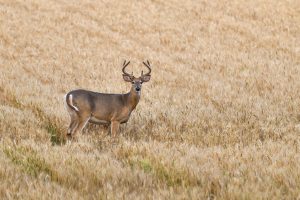
Many times the first question game managers wonder is, “What do I recommend when it comes to culling or harvesting management deer?” Just like any other question when it comes to wildlife or agricultural management, the best answer is always going to be “it depends”.
As a general rule, a whitetail buck will produce antlers that are around 45% of what they will be at maturity when they are 2.5 years old, 75% of what they will be when 3.5 and 90% of what they will be when they are 4.5. Deer are considered physiologically mature at 5.5 and are then able to put nutrition fully towards antler production and not towards body growth.
While body condition will always take precedence over antler production, these generalities can give you an idea of what the potential trophy quality will be for an individual. There will definitely be outliers to this, but these estimates are usually at the peak of the bell curve. We know antler characteristics are heritable, so in theory, if a deer is below average, the belief is that removing him from the herd will improve the chances for larger antlered deer in the herd to breed and pass on their genetics.
Even if we remove the smaller antlered individuals from the herd, at least 50% of the antler characteristics of any individual are going to come from the doe.
Here’s where it gets complicated. Even if we remove the smaller antlered individuals from the herd, at least 50% of the antler characteristics of any individual are going to come from the doe. Unless all your doe came from breeders with known pedigrees, it will be impossible to know if that doe is out of a large antlered buck and has those genetics to pass along.
Research has shown that as much as 80% of the doe can be bred by middle-aged bucks in certain conditions.
The second problem lies with who is actually doing the breeding in the herd. It is believed that mature deer do most of the breeding and many choose to only focus on taking management bucks from the mature age class. Research has shown that as much as 80% of the doe can be bred by middle-aged bucks in certain conditions. Thus, one of the biggest mistakes a manager can make when incorporating a culling program is only harvesting from the mature age class. If you are going to cull management deer, remove them from the yearling class on up.
Also, the bar should be set differently for every ranch as far as what constitutes a management deer. One ranch’s management deer will be another’s trophy. Unless you are planning to try to remove most of the native population and start over with improved genetics, the last thing you should worry about is the genetic piece of the puzzle. Management concerns like habitat improvement, carrying capacity, herd dynamics, supplemental feeding, and age structure are all more important considerations than culling. Once these dynamics are dialed in, then you may see a response by intensively harvesting management deer. However, there are very few ranches that ever reach that point.
Management concerns like habitat improvement, carrying capacity, herd dynamics, supplemental feeding, and age structure are all more important considerations than culling.
Ranches that have been “culling” are still shooting the same size deer they were 20 years ago because they haven’t focused on improving management concerns mentioned earlier. Start by working with a biologist to discuss your goals and put a plan together. The ranches that are just shooting management deer they feel are culls, will not see any response when it comes to the genetic profile or antler quality of their herd, without other concerns being addressed prior.
Article: The Great Cull Debate: Culling or Harvesting Management Deer Courtesy of Sportsman’s Choice
